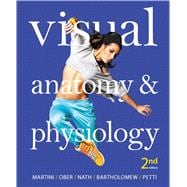Visual Anatomy & Physiology combines a visual approach with a modular organization to deliver an easy-to-use and time-efficient book that uniquely meets the needs of today’s students–without sacrificing the comprehensive coverage of A&P topics required for careers in nursing and other allied health professions. The Second Edition addresses tough physiology topics with new and revised two-page modules and corresponding new Coaching Activities in MasteringA&P®. Brand-new end-of-chapter study and practice materials include a narrative Study Outline and comprehensive Chapter Review Questions. Module Reviews and Section Reviews, appearing throughout each chapter, give students additional tools for learning. In response to the strong demand from A&P instructors, a brand-new Visual Anatomy & Physiology Lab Manual uses the same visual approach and modular organization to help students succeed in the lab.
This program presents a better teaching and learning experience by providing:
- Personalized learning with MasteringA&P: Engage students with new “tough topic” Coaching Activities and a wide range of other question and activity types—all automatically graded.
- A visual approach and modular organization: The two-page modules seamlessly integrate text and visuals to guide students through complex topics and processes with no page flipping. The addition of new content in select modules gives students a better understanding of physiology.
- Frequent practice: Review questions at the end of each module, section, and chapter encourage and support student practice. In the Second Edition, the Chapter Review includes a new narrative Study Outline and new comprehensive Chapter Review questions. Students can continue practicing with MasteringA&P.
- Learning outcomes that tightly coordinate with teaching points: The clean one-to-one correspondence between the numbered chapter-opening Learning Outcomes and the numbered two-page modules give students an easy learning path and instructors an easy vehicle for assessment.
- Streamlined learning in the lab: The new Visual Anatomy & Physiology Lab Manual uses the same visual approach and modular organization to help students succeed in the lab.
Note: You are purchasing a standalone product; MasteringA&P does not come packaged with this content. If you would like to purchase both the physical text and MasteringA&P search for ISBN-10: 0321918746 /ISBN-13: 9780321918741. That package includes ISBN-10: 0321918940/ISBN-13: 9780321918949 and ISBN-10: 0321963431/ISBN-13: 9780321963437.
MasteringA&P is not a self-paced technology and should only be purchased when required by an instructor.








